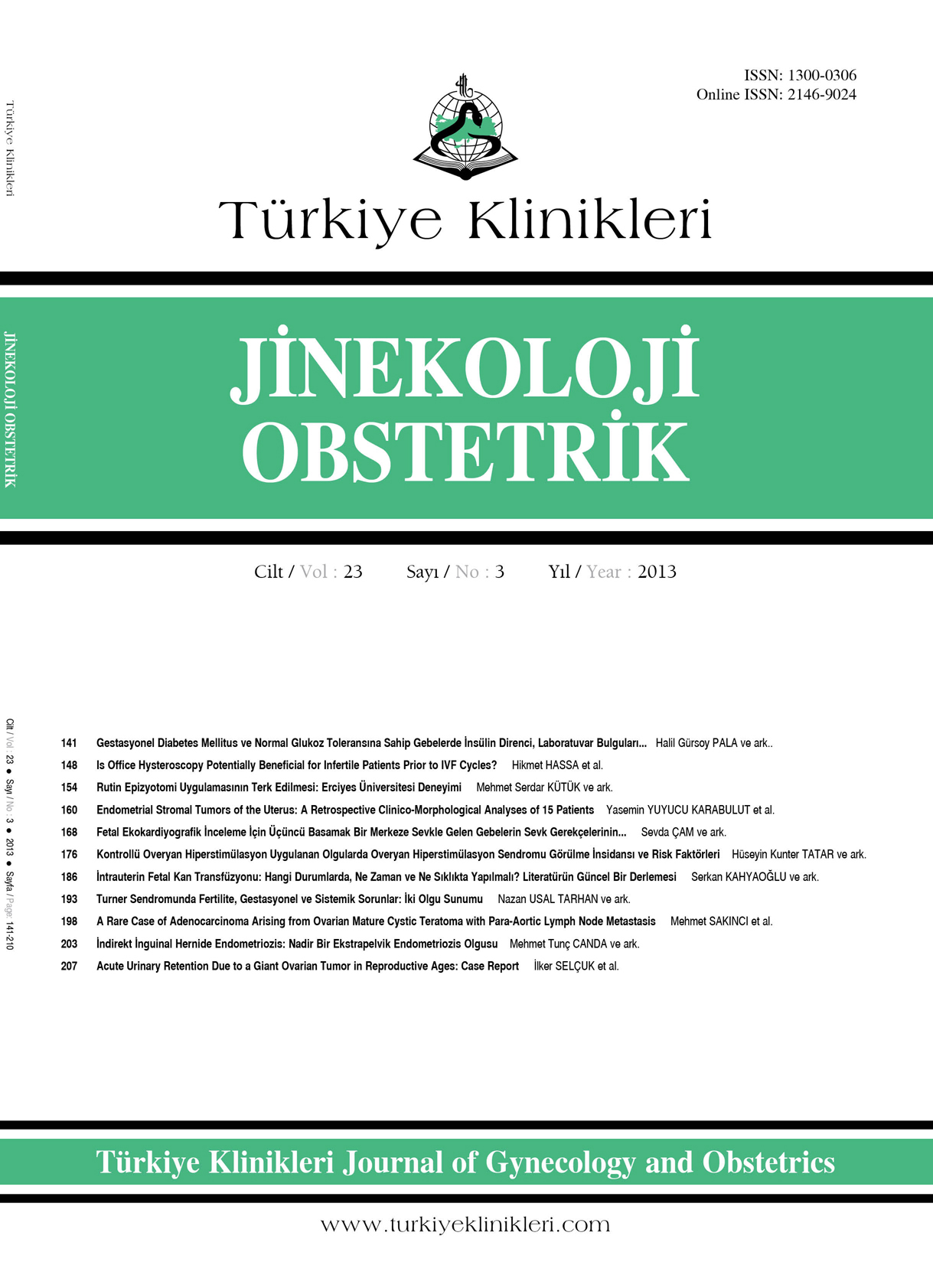Open Access
Peer Reviewed
REVIEW
4215 Viewed5544 Downloaded
Intrauterine Fetal Blood Transfusion: At Which Circumstances, When and How Often Should be Performed? A Current Review of the Literature
İntrauterin Fetal Kan Transfüzyonu: Hangi Durumlarda, Ne Zaman ve Ne Sıklıkta Yapılmalı? Literatürün Güncel Bir Derlemesi
Turkiye Klinikleri J Gynecol Obst. 2013;23(3):186-92
Article Language: TR
Copyright Ⓒ 2025 by Türkiye Klinikleri. This is an open access article under the CC BY-NC-ND license (http://creativecommons.org/licenses/by-nc-nd/4.0/)
ÖZET
Artan anti-D immünglobulin kullanımına rağmen, Rh alloimmunizasyonuna bağlı fetal anemi ile karşılaşmaktayız. Fetal aneminin sık görülen diğer nedenleri maternal parvovirüs enfeksiyonu, kronik fetomaternal kanama, eritrosit fonksiyon bozuklukları ve ikizden ikize transfüzyon sendromudur. Fetal hematokrit seviyesi %30'un altına düştüğü durumlarda intrauterin transfüzyon gerekmektedir. On sekizinci gebelik haftası ile 35. gebelik haftası arasında yapılabilen intrauterin transfüzyon; intravasküler, intraperitoneal veya kombine olarak uygulanmaktadır. Transfüze edilen kanın hematokriti günde yaklaşık %1 azaldığından 10-14 günde bir tekrarlanan transfüzyon gereksinimi olur. Her ne kadar fetal anemi tanısında orta serebral arter pik sistolik hızının median değerin bir katsayısı olarak ölçülmesi değerli olsa da, transfüzyon tekrarına ve zamanlamasına karar vermede orta serebral arter pik sistolik hızın değerli olduğunu gösteren bir kanıt yoktur. İntrauterin transfüzyon sonrası genel komplikasyon oranı %3,1 ve genel sağkalım oranı %89 olmakla beraber fetal anemi tedavisi sonrası gebelik sonuçları ciddi aneminin meydana geldiği gebelik haftasına, transfüzyon yapılan merkeze, yapan kişinin tecrübesine ve fetüste ilk başvuruda hidrops varlığına bağlıdır. İlk intrauterin transfüzyon yapıldığı anda hidropsu olan fetüslerin yaklaşık %70'i ve hidropsu olmayanların %92'si sağ kalır. Bu nedenle, anemisi olduğundan kuşkulanılan fetüslerde henüz fetal hidrops gelişmeden perkütan umbilikal kan örneklemesi yapılarak fetal hematokritin belirlenmesi ve gereği halinde eş zamanlı olarak intrauterin transfüzyon yapılması hayati önem taşır.
Artan anti-D immünglobulin kullanımına rağmen, Rh alloimmunizasyonuna bağlı fetal anemi ile karşılaşmaktayız. Fetal aneminin sık görülen diğer nedenleri maternal parvovirüs enfeksiyonu, kronik fetomaternal kanama, eritrosit fonksiyon bozuklukları ve ikizden ikize transfüzyon sendromudur. Fetal hematokrit seviyesi %30'un altına düştüğü durumlarda intrauterin transfüzyon gerekmektedir. On sekizinci gebelik haftası ile 35. gebelik haftası arasında yapılabilen intrauterin transfüzyon; intravasküler, intraperitoneal veya kombine olarak uygulanmaktadır. Transfüze edilen kanın hematokriti günde yaklaşık %1 azaldığından 10-14 günde bir tekrarlanan transfüzyon gereksinimi olur. Her ne kadar fetal anemi tanısında orta serebral arter pik sistolik hızının median değerin bir katsayısı olarak ölçülmesi değerli olsa da, transfüzyon tekrarına ve zamanlamasına karar vermede orta serebral arter pik sistolik hızın değerli olduğunu gösteren bir kanıt yoktur. İntrauterin transfüzyon sonrası genel komplikasyon oranı %3,1 ve genel sağkalım oranı %89 olmakla beraber fetal anemi tedavisi sonrası gebelik sonuçları ciddi aneminin meydana geldiği gebelik haftasına, transfüzyon yapılan merkeze, yapan kişinin tecrübesine ve fetüste ilk başvuruda hidrops varlığına bağlıdır. İlk intrauterin transfüzyon yapıldığı anda hidropsu olan fetüslerin yaklaşık %70'i ve hidropsu olmayanların %92'si sağ kalır. Bu nedenle, anemisi olduğundan kuşkulanılan fetüslerde henüz fetal hidrops gelişmeden perkütan umbilikal kan örneklemesi yapılarak fetal hematokritin belirlenmesi ve gereği halinde eş zamanlı olarak intrauterin transfüzyon yapılması hayati önem taşır.
ANAHTAR KELİMELER: Kan tranfüzyonu, intrauterin; fetal tedaviler
ABSTRACT
Although increasing utilization of anti-D immunglobulin recently, we encounter fetal anemia secondary to Rh alloimmunisation. Other most common reasons of fetal anemia are maternal parvovirus infection, chronic fetomaternal bleeding, eritrocyte function disorders and twin to twin transfusion syndrome. Intrauterine transfusion is mandatory when fetal hematocrit level falls below 30%. Intrauterine transfusion, that can be performed between 18 and 35 weeks of gestation, is utilized via intravasculary, intraperitoneally and combined fashions. Repeated transfusions are needed by 10-14 days from the initial transfusion because the hematocrit level of the transfused blood falls by 1% daily. However, the multiple of median value of middle cerebral artery of the fetus is worthy to establish the diagnosis of fetal anemia, current data is insufficient for recommendation of the measurement of multiple of median value of middle cerebral artery to decide the timing of the subsequent transfusion. Besides the overall complication rate is 3.1% and the overall survival rate is 89% following intrauterine transfusion, pregnancy outcomes of fetal anemia treatment vastly depends on the gestational age upon establishment of fetal anemia diagnosis, the medical center that hosts transfusion process, personel experience of the clinician and presence of fetal hydrops at admission. Seventy percent of the fetuses with fetal hydrops and 92% of the ones without fetal hydrops survive following intrauterine transfusion. Therefore, before the establishment of fetal hydrops, among fetuses suspected to have anemia, it is of paramount importance to perform a percutaneous umbilical blood sampling and a concurrent intrauterine transfusion procedure when needed.
Although increasing utilization of anti-D immunglobulin recently, we encounter fetal anemia secondary to Rh alloimmunisation. Other most common reasons of fetal anemia are maternal parvovirus infection, chronic fetomaternal bleeding, eritrocyte function disorders and twin to twin transfusion syndrome. Intrauterine transfusion is mandatory when fetal hematocrit level falls below 30%. Intrauterine transfusion, that can be performed between 18 and 35 weeks of gestation, is utilized via intravasculary, intraperitoneally and combined fashions. Repeated transfusions are needed by 10-14 days from the initial transfusion because the hematocrit level of the transfused blood falls by 1% daily. However, the multiple of median value of middle cerebral artery of the fetus is worthy to establish the diagnosis of fetal anemia, current data is insufficient for recommendation of the measurement of multiple of median value of middle cerebral artery to decide the timing of the subsequent transfusion. Besides the overall complication rate is 3.1% and the overall survival rate is 89% following intrauterine transfusion, pregnancy outcomes of fetal anemia treatment vastly depends on the gestational age upon establishment of fetal anemia diagnosis, the medical center that hosts transfusion process, personel experience of the clinician and presence of fetal hydrops at admission. Seventy percent of the fetuses with fetal hydrops and 92% of the ones without fetal hydrops survive following intrauterine transfusion. Therefore, before the establishment of fetal hydrops, among fetuses suspected to have anemia, it is of paramount importance to perform a percutaneous umbilical blood sampling and a concurrent intrauterine transfusion procedure when needed.
MENU
POPULAR ARTICLES
MOST DOWNLOADED ARTICLES





This journal is licensed under a Creative Commons Attribution-NonCommercial-NoDerivatives 4.0 International License.










